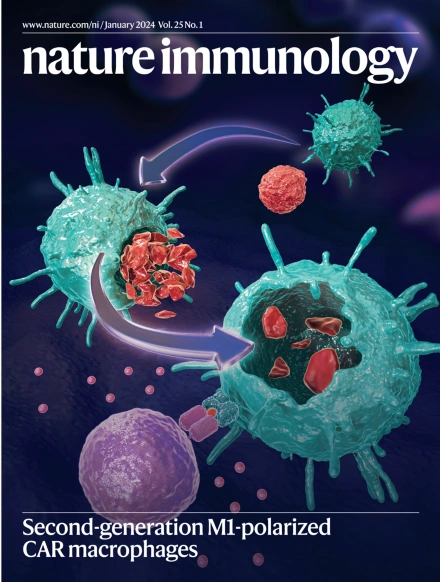MEF2C在人小胶质细胞中的转录和表观遗传靶点参与与自闭症风险和年龄相关疾病相关的细胞功能。
IF 27.6
1区 医学
Q1 IMMUNOLOGY
引用次数: 0
摘要
MEF2C编码一种在神经系统发育中起关键作用的转录因子。为了研究MEF2C在人类小胶质细胞中的疾病相关功能,我们分析了MEF2C单倍缺失和MEF2C敲除诱导的多能干细胞系分化的小胶质细胞。互补转录组学和功能分析显示,MEF2C的缺失导致高炎症表型,包括广泛的吞噬功能障碍、脂质积累、溶酶体功能障碍和基础炎症细胞因子分泌升高。mef2c结合位点的全基因组分析加上活跃的调控景观,可以推断其转录功能和mef2c相关细胞功能的潜在机制。转录组学和表观遗传学方法发现了与特发性自闭症数据集的大量重叠,表明人类小胶质细胞MEF2C失调在特发性自闭症中发挥了更广泛的作用。在小鼠异种移植模型中,MEF2C的缺失导致体内人小胶质细胞形态、溶酶体和脂质异常。总之,这些研究揭示了减少小胶质细胞MEF2C可能促进神经系统疾病发展的机制。本文章由计算机程序翻译,如有差异,请以英文原文为准。
Transcriptional and epigenetic targets of MEF2C in human microglia contribute to cellular functions related to autism risk and age-related disease.
MEF2C encodes a transcription factor that is critical in nervous system development. Here, to examine disease-associated functions of MEF2C in human microglia, we profiled microglia differentiated from isogenic MEF2C-haploinsufficient and MEF2C-knockout induced pluripotent stem cell lines. Complementary transcriptomic and functional analyses revealed that loss of MEF2C led to a hyperinflammatory phenotype with broad phagocytic impairment, lipid accumulation, lysosomal dysfunction and elevated basal inflammatory cytokine secretion. Genome-wide profiling of MEF2C-bound sites coupled with the active regulatory landscape enabled inference of its transcriptional functions and potential mechanisms for MEF2C-associated cellular functions. Transcriptomic and epigenetic approaches identified substantial overlap with idiopathic autism datasets, suggesting a broader role of human microglial MEF2C dysregulation in idiopathic autism. In a mouse xenotransplantation model, loss of MEF2C led to morphological, lysosomal and lipid abnormalities in human microglia in vivo. Together, these studies reveal mechanisms by which reduced microglial MEF2C could contribute to the development of neurological diseases.
求助全文
通过发布文献求助,成功后即可免费获取论文全文。
去求助
来源期刊

Nature Immunology
医学-免疫学
CiteScore
40.00
自引率
2.30%
发文量
248
审稿时长
4-8 weeks
期刊介绍:
Nature Immunology is a monthly journal that publishes the highest quality research in all areas of immunology. The editorial decisions are made by a team of full-time professional editors. The journal prioritizes work that provides translational and/or fundamental insight into the workings of the immune system. It covers a wide range of topics including innate immunity and inflammation, development, immune receptors, signaling and apoptosis, antigen presentation, gene regulation and recombination, cellular and systemic immunity, vaccines, immune tolerance, autoimmunity, tumor immunology, and microbial immunopathology. In addition to publishing significant original research, Nature Immunology also includes comments, News and Views, research highlights, matters arising from readers, and reviews of the literature. The journal serves as a major conduit of top-quality information for the immunology community.
 求助内容:
求助内容: 应助结果提醒方式:
应助结果提醒方式:


